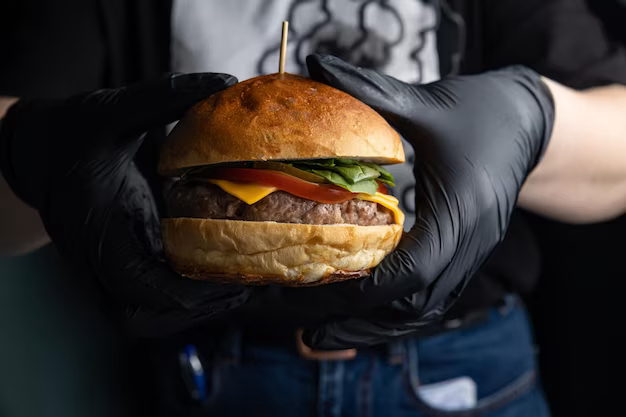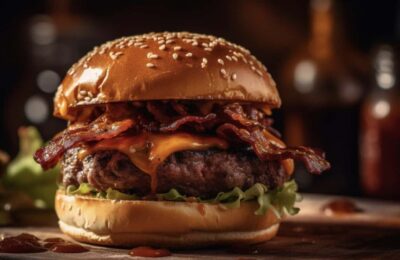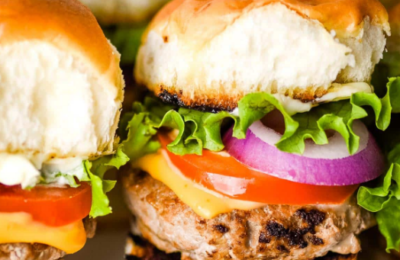Cooking the quintessential grilled burger is an art that’s often associated with memorable times spent around the barbecue with loved ones. While there are countless ways to flavor and present a burger, one universal rule ensures its enjoyment: attaining the proper temperature for a safe and flavorsome bite.
This article is a profound journey into the realm of burger grilling. Here, we’ll demystify the ideal burger temperature, highlight the pitfalls of undercooked beef, and spill the secrets to handling ground meat safely. Embark on this exploration to bring the tantalizing taste of perfectly grilled burgers to your backyard gathering.
The Perfect Burger Temperature: A Guide
A fine line separates a juicy, well-cooked burger from a potential health risk. Understanding the right hamburger temperature is paramount for both taste and safety. Here are the recommended temperatures for burgers, based on your preference:
- Rare: 120°F to 125°F;
- Medium Rare: 130°F to 135°F;
- Medium: 140°F to 145°F;
- Medium Well: 150°F to 155°F;
- Well Done: 160°F to 165°F.
The Core Temperature of Burgers Vs. Steaks: What’s Safe and What’s Not?
Cooking a meal that is both savoury and safe is an integral part of the culinary art. When the conversation steers towards meat dishes, particularly a sizzling steak or a juicy burger, there’s often a question that arises: why is it safe to enjoy a rare steak, but not a rare burger? The answer revolves around the invisible enemy in the culinary world: bacteria.
Bacteria are omnipresent, including on the surface of the meats we consume. For whole cuts of meat like steaks, bacteria remain on the outer layer. These surface microbes don’t penetrate deeper into the meat. Hence, searing a steak at high temperatures eliminates this surface bacteria, making the inside safe to eat, even when it’s medium-rare or rare.
The freshness of the steak also plays a critical role in its safety. Some indications of a fresh steak include a bright red color, a firm texture, and a mild scent. If you notice a slimy texture, discoloration, or an off-putting smell, it’s best to discard the steak as these are signs of spoilage.
On the other hand, burgers present a different scenario. The act of mincing or grounding the meat intermingles the surface bacteria throughout the entire patty. This spread of bacteria inside the patty necessitates the burger to be thoroughly cooked to a safe internal temperature of 160°F, ensuring the elimination of any bacteria that migrated during the grinding process.
In contrast, a steak can safely be consumed when it reaches an internal temperature of 130°F.
Decoding the USDA Guidelines for Safe Hamburger Temperatures
Grilling the ideal burger involves not just a blend of spices but also a precise science of temperature. According to the USDA, this science dictates that all ground meat, used for preparing burgers, should be cooked to an internal temperature of at least 160°F. This applies to various types of meat, including pork, beef, veal, and lamb.
This threshold temperature of 160°F is recommended to ensure that any harmful bacteria are completely eradicated, rendering the meat safe for consumption. Keep in mind that the temperature gauge should be placed in the thickest part of the patty to get the most accurate result.
In contrast to the 160°F guideline for ground meat, the USDA has set an even higher temperature standard for chicken and other poultry. When preparing a chicken burger, the meat should reach an internal temperature of at least 165°F to ensure it’s thoroughly cooked and safe to eat.
It’s worth noting that these temperature recommendations apply largely to store-bought ground meat. Commercially processed meat carries a higher risk of bacterial contamination due to the extensive handling and grinding processes it undergoes. However, if you’re grinding your meat at home under sanitary conditions, the risk of bacterial presence significantly diminishes.
The Art of Safe Food Preparation: Hamburger Edition
While the source and quality of your ground beef play significant roles in ensuring a safe and delightful burger, your kitchen habits during preparation and cooking are equally vital. Here are some helpful practices to keep your kitchen clean and your food safe:
1. Maintain Ideal Beef Temperature
Always store your ground beef in a refrigerated environment at or below 40°F. This reduces the rate at which bacteria multiply, keeping the meat fresh and safe for a longer duration.
2. Adopt Segregated Prep Areas
Cross-contamination is a common way harmful bacteria can spread in your kitchen. Designate separate work areas and utensils for meat and vegetables to keep them separate during preparation.
3. Practice Hand Hygiene
Clean hands can dramatically reduce the spread of bacteria. Wash your hands thoroughly with warm water and soap before you start preparing your food and do the same after handling raw meat.
4. Keep Your Kitchen Clean
Using a disinfectant, thoroughly clean all kitchen surfaces and utensils before and after cooking. This includes cutting boards, knives, and especially any thermometers you use to check meat temperatures.
5. Isolate Ready-to-Eat Foods
To avoid any cross-contamination, keep ready-to-eat foods and their utensils separate from raw foods and their liquids. This practice further ensures the safety of your meal.

Harnessing the Power of Hand-Ground Meat for Burgers
The art of making the perfect burger can be significantly elevated by grinding your own meat. Doing so not only allows you greater control over the quality and freshness of the meat but also provides an opportunity to play around with flavors and textures.
When buying a whole cut of meat, consider opting for a well-marbled chuck. This cut is a favorite among burger enthusiasts due to its optimal fat content, which promises a well-flavored and moist burger.
In the world of burgers, fat is your friend! Aim for a blend that contains around 15-20% fat. This ensures a juicy result while keeping the overall dish balanced and not overly greasy. Ground chuck fits the bill perfectly, marrying affordability with an ideal fat-to-meat ratio.
For those food adventurers willing to try something different, mixing ground meats can yield a unique flavor profile. Consider blending various cuts of beef or experimenting with combinations of beef and pork, or even beef and chorizo for an exciting twist.
Conclusion
In conclusion, grinding your own meat for burgers provides a whole new dimension to the burger-making experience. Not only does it enhance the freshness and quality of the burgers, but it also unleashes endless possibilities of flavor combinations. Whether you’re a seasoned cook or a novice in the kitchen, grinding your own meat can take your burger to the next level of gastronomical delight. So, strap on your apron, rev up the meat grinder, and start concocting your masterpiece!


